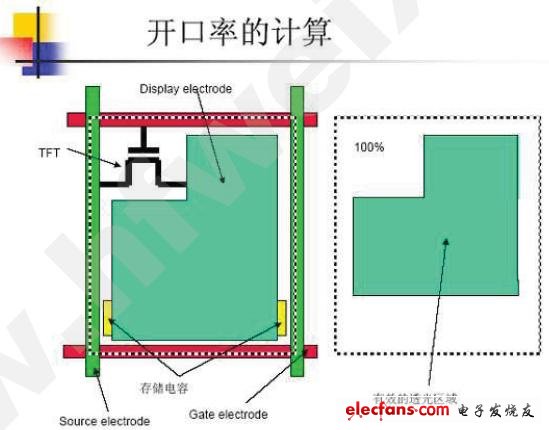Aperture raTIo A very important specification in the LCD is brightness, and the most important factor in determining brightness is the aperture ratio. What is the aperture ratio? Simply put, it is the ratio of the effective area through which light can pass. The left side of the figure below is a structure diagram of a liquid crystal display viewed from above or directly below. When light is emitted through the backlight panel, not all light can pass through the panel, such as signal traces for the LCD source driver chip and gate driver chip, the TFT itself, and storage capacitors for storing voltage, etc. . In addition to incomplete light transmission in these places, because the light passing through these places is not controlled by the voltage and cannot display the correct grayscale, so they need to be masked by the black matrix to avoid interference with the correct brightness of other light-transmitting areas . Therefore, the effective light transmission area is only the area shown on the right side of the figure below. The ratio of this effective light-transmitting area to the entire area is called the aperture ratio. When the light is emitted from the backlight, it will pass through the polarizer, glass, liquid crystal, color filter, etc. in order. Assume that the transmittance of each part is as follows: polarizer 50% (because it only allows one direction Polarized light wave through), glass 95% (two upper and lower pieces need to be calculated), liquid crystal 95%, aperture ratio 50% (effective light transmission area is only half), color filter 27% (assuming the material itself has a transmittance 80%, but because the filter itself is painted with color, it can only allow light waves of that color to pass. In the case of the RGB three primary colors, only one of the three can be allowed to pass, so only one-third of the brightness is left. Therefore, only 80% * 33% = 27% can be passed. ) Based on the above-mentioned penetration rate, only 6% of the light from the backlight board is left, which is really pitiful. This is why in the design of TFT LCD, the aperture ratio should be increased as much as possible. As long as the aperture ratio is increased, the brightness can be increased, and at the same time, the brightness of the backlight panel is not so high, which can save power consumption and cost.
Wireless Battery Par Lights Series
It is built with D-Fi transceiver. This wireless battery led light can be controlled by wireless DMX or IR remote controller. It's convenient for home parties, events, and any other places requiring a small fixture lighting up the venue. Shine light where it is needed using the built-in adjustable kickstand and prevent light spillage with the built-in glare shield.
DMX cables can be removed, wireless connection is available without any signal interference. With in-built lion battery, power cables can be removed, each light can be placed seperately without any cable connection, while they are wirelessly connected for the controlling. The charging time is about five hours, while working time reaches 8-12 hours. It is small in size: 15*14*23cm, stuitable for lighting up a truss.
Our company have 13 years experience of LED Display and Stage Lights , our company mainly produce Indoor Rental LED Display, Outdoor Rental LED Display, Transparent LED Display ,Indoor Fixed Indoor LED Display, Outdoor Fixed LED Display, Poster LED Display , Dance LED Display ... In additional, we also produce stage lights, such as beam lights Series, moving head lights Series, LED Par Light Series and son on...
Wireless Battery Par Light Series,Beam 230 7r,Stage Beam Light,Moving Head Stage Lights Guangzhou Chengwen Photoelectric Technology co.,ltd , https://www.cwledpanel.com